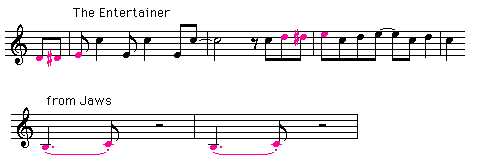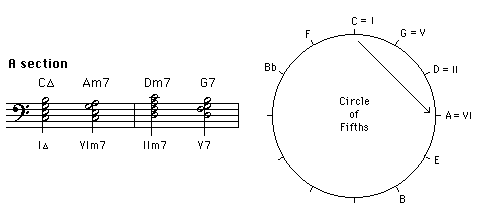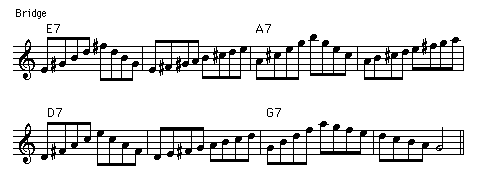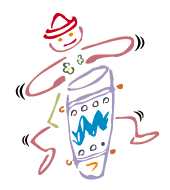(Down - Top -
Links)
S 11.1 - Semitone
Symmetry

|
In the Session 10 I introduced the concept
of Whole-tone symmetry which
produces musical elements using intervals consisting of an even number of semitones (whole
tones, and multiples of whole tones).
Semitone symmetry is a
second form of simple symmetry, where the symmetrical interval
consists of an odd number of
semitones. There is a distinct difference in
sound between these two groups.
Whole-tone symmetry produces aggressive, angular
sounds invariably used over dominant, augmented and altered
major chords.
Semitone symmetry, on the other hand, produces much
smoother sounds, from which all aggressiveness and angularity
have disappeared. Semitone symmetry can be applied
over any chord in any situation, providing a lubricant
between one chord (or tone) and the next, and at the same time
contributing an additional colour to the music.
There are
only two elements with simple semitone symmetry in music. They
are the Chromatic scale and
the diminished 7th chord.
|
In the Chromatic scale all
notes are spaced at intervals of one
semitone. It contains all notes used in our present
system of traditional Western music.
Initially notes of the
chromatic scale were simply used to add
colour ("chroma" means "colour") to other (major and
minor scale) tonalities.
From the early 1900s the scale started to become used in its
own right (e.g. in the atonal
music pioneered by Arnold
Schönberg). To mark this upgraded use the name
Dodecaphonic scale (meaning
"twelve-tonal") was introduced, however this name never really
took hold.
Audio 11.1

The Chromatic scale is, like all other symmetrical elements,
ambiguous in its tonality. Any note of the scale can function as
the tonic note, but the feeling of a tonal centre is absent. The
sound of chromatic scale segments and simple semitone movements
can be as smooth as butter (as in Scott Joplin's 'The
Entertainer'), but it can also produce a "spooky" mysterious
sound (like in the film "Jaws"), especially when going upwards in
pitch.
Audio 11.2

The four notes of the diminished 7th
chord divide the octave into four symmetrical
intervals of three semitones (a 'minor 3rd' interval) each.
Audio 11.3

The diminished 7th chord is the ideal and commonly used tool to
harmonise non-chord or non-scale tones in a melody. It is also
used (especially in the older Trad Jazz standards) as a passing chord between two chords to
smooth out a chord progression.
For example :
Audio 11.4

|
The diminished triad (such as Co = C Eb Gb), although
strictly speaking not a symmetrical chord, is used in the same
way as its bigger brother (Co7 = C Eb Gb A). It can be
interpreted (by the ear) as a diminished 7th chord with one note
missing in the voicing. |
(Down - Up -
Top - Links)
S 11.2 - The Jam Factory
The Jam Factory is a
32 bar song in AABA format. It has the same chord progression as
one of the most famous Standards of the Jazz repertoire : I Got Rhythm by George Gershwin.
The chord progression of this song is used in numerous other Jazz
standards. Famous examples include Oleo by Sonny Rollins
and Anthropology by Charlie Parker.
Jamey Aebersold
lists 61 titles in his Vol.47 - I Got Rhythm Changes in all
Keys Play-a-Long CD set.
I have used simplified versions
of it for my songs 'Hey There', 'Where's Woody?', 'At the Hannans
Ball' and 'Swing Time'. |
Note the long phrase of quavers (4 bars plus 1 beat) over the
first half of the A section of The Jam Factory.
Melody

The A section of The Jam
Factory consists entirely of the popular chord segment
I - VIm7 - IIm7 -
V7
in C = C - Am7 - Dm7 - G7
All chords are scale-tone chords of the same scale (C major in
the case of 'The Jam Factory'). This makes improvisation over the
A sections very easy, as you only need to use the one C major
scale to cover all chords.
Audio 11.5

The Bridge of The Jam
Factory consists of two 4 bar phrases with identical rhythm
patterns.
The melody in the second phrase "echoes" the first
phrase, shifted one tone down with appropriate alterations to fit
the chords.
(This can also be a very effective ploy in improvisation.)
Audio 11.6

The chords in the Jam
Factory Bridge (or 'B section') represent the so-called
Rhythm Bridge used in
numerous Jazz standards.
In this section the song modulates to a new key with every new
dominant chord.
III7 - VI7 - II7 -
V7
in C = E7 - A7 - D7 - G7
Audio 11.7

You therefore need to use four different scales for improvisation
over the Bridge.
Here is a good Practice routine to use.
Audio 11.8

(Down - Up -
Top - Links)
S 11.3 - Phrasing : Using non
scale-tones
In the selection of which notes to use for improvisation you
have two choices.
- Playing inside the
tonality that fits the chord.
This consists of scale segments,
arpeggios and large intervals within the scale.
- Playing outside the
tonality that fits the chord.
This can be done in two ways.
- deliberate selection of a scale that partly or entirely
does not fit the chord, like we did for example in Y2K Blues.
- or by occasionally adding a non scale-tone to the
improvised melody.
In this case you do not really play outside
the tonality, but merely add colour to it.

| Work in this session on adding a non scale-tones to your
improvisation. This can be especially effective over large areas
which are covered by one scale only, such as the A sections of
Jam Factory. Be careful
not to overdo it, otherwise the tonality gets to vague to be
meaningful. By using non scale-tones you are in effect using
the tonality of the chromatic
scale. As this scale contains all the notes of the
musical system it "fits" over any chord imaginable.
You can
therefore include a chromatic
run at any point in any of your improvisations. This
can be very useful when you run out of ideas or wish to shift to
a higher or lower pitch level in your improvisation.
|
Swapping twos
Again included in this session some tracks swapping twos.
- On Jam Factory 1 I play every first
two bars of each 4 bar phrase, you play the last two
bars.
- On Jam Factory 2 I play every
last two bars of each 4 bar phrase, you play the
first two bars.
- On Jam Factory 3 you can listen to
the combined result.
(Down - Up -
Top - Links)
S 11.4 - Practice : Chromatic
and Whole-tone scales
Practice the chromatic
scale and the whole-tone scale over a 2 octave range on your
instrument. Learn to start and turn these scales on any note.
Chromatic scale fingerings for Keyboard - Saxophone - Clarinet - Flute are included in a separate article.
I have no expertise in
fingering technique on other instruments (brass, strings, etc.),
and recommend you check these out in a good tutor book for your
instrument.
(Down - Up -
Top - Links)
S 11.5 - Session
Materials